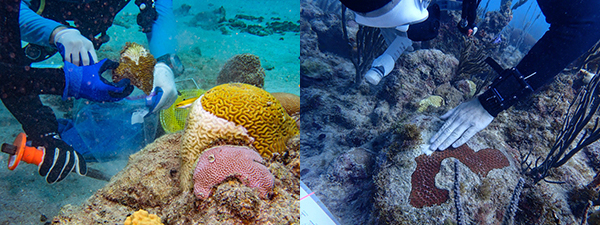- ABOUT US
- PROGRAM AREAS
- CONSERVATION APPROACH
- EDUCATION
- MULTIMEDIA
- Build on goals and agency priorities identified in the NOAA Strategy for SCTLD Response and Prevention;
- Outline a detailed, five-year course of action for SCTLD response and prevention;
- Match agency capacity with SCTLD response needs and complement and enhance the efforts of our partners; and,
- Highlight key actions necessary to understand and address this new threat to coral reefs over the long-term.
- NOAA Strategy for Stony Coral Tissue Loss Disease Response and Prevention
- Coral Heroes: The Stony Coral Tissue Loss Disease Response Team
- How Can the National Coral Reef Monitoring Program Help Inform Stony Coral Tissue Loss Disease Monitoring?
- U.S. Coral Reef Task Force Coral Disease Working Group
- Coral Reef Conservation Financial Assistance
Release of NOAA's Implementation Plan for Stony Coral Tissue Loss Disease Response and Prevention
The NOAA Strategy for Stony Coral Tissue Loss Disease (SCTLD): An Implementation Plan for Response and Prevention aims to:
The implementation plan provides key actions by NOAA and partners that will increase understanding of and response to the disease in the Atlantic and Caribbean region and prevent its spread to the Indo-Pacific. It presents a clear, specific plan of action that can be used to secure funding for key disease research, response, engagement, and prevention activities over the next five years (2022-2027).

Recognizing that SCTLD will be present on U.S. coral reefs for the foreseeable future, the implementation plan also outlines key actions necessary to address this new threat over the long-term. While it is unlikely that SCTLD will be fully eradicated as a result of this implementation plan, the plan provides major gains in reducing the likelihood of further transmission; preparing vulnerable areas in the event the disease reaches them; saving priority corals in regions whose corals are being heavily impacted; and, contributing to future restoration of highly susceptible species whose populations have been devastated in many areas.

Atlantic-Caribbean coral reef ecosystems are in the midst of an unprecedented outbreak of a newly described coral disease, Stony Coral Tissue Loss Disease (SCTLD). This particular disease affects at least 22 ecologically important shallow-water reef-building coral species, five of which are listed as threatened species under the Endangered Species Act. The disease is characterized by rapid spread, rapid tissue loss, and high mortality rates of affected colonies. While SCTLD was first reported on Florida’s Coral Reef in 2014, reports of its spread to the wider Caribbean region began to occur in early 2018. As of August 2022, SCTLD has affected corals along the entirety of Florida’s 360-mile long reef system and has been reported in 22 Caribbean countries and territories, including the U.S. Virgin Islands and Puerto Rico. As of September 2022, the appearance of a SCTLD-like disease was documented at Flower Garden Banks.
Following the publication of the implementation plan, NOAA and partners will work to identify feasible funding sources to enable the implementation of the activities in this plan. Once funding is secured, NOAA-led projects will be implemented through NOAA's Coral Reef Conservation Program. Partner-led projects will be supported via grants and external funding. It is anticipated that the majority of funds called for to support this plan will be allocated to external partners via grants.
Related Stories and Products
About Us

The NOAA Coral Reef Conservation Program was established in 2000 by the Coral Reef Conservation Act. Headquartered in Silver Spring, Maryland, the program is part of NOAA's Office for Coastal Management.

The Coral Reef Information System (CoRIS) is the program's information portal that provides access to NOAA coral reef data and products.
Work With US
U.S. Coral Reef Task Force
Funding Opportunities
Employment
Fellowship Program
Contracting Assistance
Graphic Identifier
Featured Stories Archive

Access the archive of featured stories here...
Feedback
Thank you for visiting NOAA’s Coral Reef Conservation Program online. Please take our website satisfaction survey. We welcome your ideas, comments, and feedback. Questions? Email coralreef@noaa.gov.
Stay Connected
Contact Us
NOAA’s Coral Reef Conservation Program
SSMC4, 10th Floor
1305 East West Highway
Silver Spring, MD 20910
coralreef@noaa.gov
